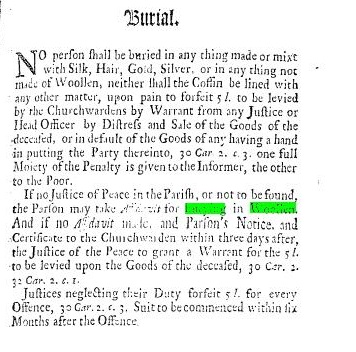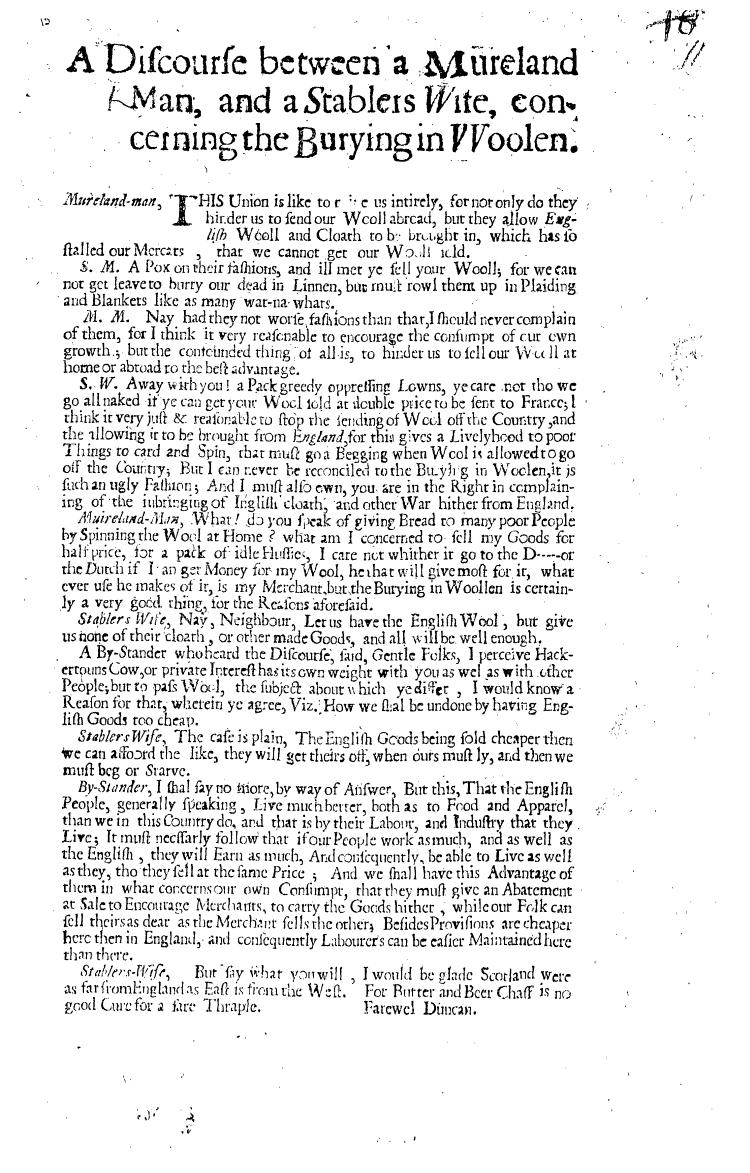Did you know that in 1678 an act was passed in the British Parliament decreeing that the dead must only be buried in WOOL and not in any other sort of textile?

A guide to Justices of the Peace on how to enforce the “Burial in Woollens Act,” dated 1710.
It seems that the act was passed in order to create a compelling reason for folk to stop illegally smuggling wool out of the UK. If the wool was legally required for entombing the dead, (so the reasoning went) the same communities which assisted the illegal export of wool out of the country would be obliged to demand that it remain in Britain. The threat of imprisonment, or – in the case of poor Joan Diamond being exhumed if incorrectly buried – was enough to make civilians join forces with the authorities to keep wool in the country. As Hufton & Baird observe:
The struggle to protect the wool cloth trade from all assaults took a truly bizarre turn in 1678 when an act ordered that the dead should be buried only in woollen shrouds, that registers and affidavits guaranteeing the material of the shrouds should be kept and be open to inspection. The words of the act have a final biblical ring, saying witnesses to the affidavit had to swear that the body, ‘was not put in wrapt or wound up or buried in any shirt, shift, sheet or shroud made or mingled with flax, hempe, silke, haire, gold or silver or other than what is made of sheeps wool only’.
Ardent bibliographers have tried to argue that the purpose of this act was to save linen rags for paper-making, as paper which at that time was made mainly of linen rags was of poor quality and in short supply. This is not so, its purpose was to protect the cloth trade which was so sorely beleaguered by the activities of the wool smugglers. The act, ridiculous as it may seem, was more easily put into action than any of the legislation against armed smugglers: some affidavits and registers still exist, and there is one in the Parish Registers for Sedlescombe in 1745. Also in these registers is the chilling entry, in 1710, ‘Joan Diamond, a traveller, was buried on July 2nd, and because not buried in wool, then taken up again and reburied’.
The authorities, however, were apparently satisfied that in this respect at least they were protecting the wool trade, and combating ‘the misery of England’ by the ‘wool stolen out of the Kentish, Essex and Sussex Coasts’ and the consequent unemployment bemoaned by William Carter, and we learn from the Gazette in 1688 that widow Amy Potter, ‘has made of woollen only decent and fashionable laced dresses for the dead, as well as other plainer, for burying in woollen will be much quieted, and many hundreds of subjects employed’.
After the dizzy success of the ‘Burial in Woollen Act’, the authorities continued to address themselves to limiting the activities of the smugglers.
Geoffrey Hufton & Elaine Baird, Smuggling in Kent and Sussex, 1983
It seems that the textile trades in Scotland and Ireland were displeased with this bit of British Ruling, as prior to the ‘Burial in Woollen Act’ it had been customary in both Scotland and Ireland for the deceased to be shrouded in linen.
In 1707 – just after the act of union between England and Scotland – a pamphlet was published in Scotland declaring “a pox on their [British] fashions… we cannot get leave to bury our dead in linen but must rowl them up in plaiding and blankets like as many wat-na-whats.”

Scottish Pamphlet, published 1707
The absurd wool burying act was extended to Ireland in 1733. Jonathan Swift refers to the differences between Irish and English burial textiles in the following poem:
To live in this or t’other isle
We cannot think it worth your while
For, take it kindly or amiss,
The difference but amounts to this
We bury on our side the channel
In linen; and on yours in flannel
Jonathan Swift, On Mr Ford’s birthday, 1723
One final note: if you think these ideas about cadaverous uses of wool are a thing of the past, think again. Woollen coffins may still be purchased today which I personally think is a good thing, considering wool’s sustainable, biodegradable qualities.
However, I absolutely draw the line at creating a legal obligation for folk to choose to be buried in them, no matter how passionately I love WOOL!